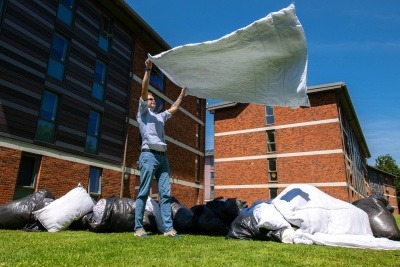Almost a quarter of home textiles currently thrown away
WRAP report finds that items such as towels, linen and curtains represent a missed opportunity for recycling and reuse.
 Almost a quarter of home textiles, including towels, curtains and linen, end up in the residual bin, according to new consumer research published by WRAP.
Almost a quarter of home textiles, including towels, curtains and linen, end up in the residual bin, according to new consumer research published by WRAP.
The report, titled ‘Citizen Insights: Estimating the Longevity of Home Textiles in the UK’, aims to provide insights into the lifespan of textiles and to inform circular business guidelines.
The study suggests that promoting proper care of home textiles can extend product lifespan and reduce environmental impacts. It also highlights the potential for circular business models, encouraging consumers to reuse, repair, upcycle, resell, or rent textiles, and for retailers to design durable, recyclable products.
The home textiles covered by the report include bed sheets, duvet covers, bathroom towels, fabric tablecloths, fabric curtains/blinds, cushion covers, bedspreads/throws, rugs, duvets and pillows.
The typical UK household harbours 56.9 home textile items, with the majority of those being bathroom towels, cushion covers, pillows and bed sheets. Of these, ‘just over a fifth, 12 items, will not have been used.
Disposal of home textiles
Once an item of home textiles has been decommissioned, the most common end-of-life route is the residual waste stream (22 per cent). Charity shops come a close second, handling 21 per cent of unwanted home textiles. Another 20 per cent is taken to a dedicated recycling area at the HWRC, while 18 per cent is repurposed within the home e.g. as cleaning rags or pet bedding.
At the other end of the scale, retailer take-back schemes handle five per cent, six per cent is sold in-person at places like car boot sales, and seven per cent is sold through online platforms and marketplaces.
Speaking about the findings, Harriet Lamb, CEO at WRAP, said: “The home furnishings market is worth £13.6bn a year but sadly too much of it ends up going in the bin - close to half all textiles waste is not from clothing but such furnishings.”
WRAP’s research highlighted how different types of home textiles are disposed of in different ways, with pillows, duvets, bath towels and bed sheets being the most likely to end up in the residual waste. Tablecloths, bedspreads, throws, curtains and blinds are most likely to be sent to a charity shop.
Commenting on WRAP’s research, Alan Wheeler, CEO of the Textile Recycling Association, said: “Like clothing, there is often a value to good quality reusable household textiles. However, for these products to become more sustainable and circular we require further research and market development into new textile recycling markets which could be supported and delivered by policy interventions such as Extended Producer Responsibility, product design standards and minimum recycled content in new textile products.”
The report’s recommendations
WRAP’s research revealed that behaviours for home textiles fall behind those for clothing, and pulling insights together, WRAP encourages guidance for businesses and consumers with care and disposal specific to the different types of product.
Consumers, WRAP says, should first check with local charity shops to see which items are accepted, and – if unsuccessful – should find and use a collection point to ensure waste fabric is reclaimed to be made into a new product.
WRAP pressed the point that citizens should be supported and motivated to reuse home textiles or to send them for recycling – avoiding putting them in the bin at all costs. Building awareness of unused textiles can also help increase their active use, as non-use is often driven by perceptions rather than product failure.
Take-back schemes were highlighted as a ‘significant opportunity’ for home textiles retailers and the recycling sector; to bring a higher proportion of home textiles into active use. By implementing these, they can address the current lack of clear disposal routes for consumers.
By designing products with circularity in mind, brands and retailers can reduce the environmental impact of home textiles. In addition, WRAP identifies an opportunity to establish circular business models in the sector, shifting the focus from selling products to promoting sustainable concepts. This change will help businesses and consumers embrace sustainable practices, ultimately benefiting the environment.
Reflecting on the opportunity, Lamb added: “As we all understand more about the impact of our clothes on the planet, people are increasingly browsing through charity shops or other places for pre-loved outfits. Now is the chance to think in much the same way about home furnishings. Personally, I love the perfectly good curtains I bought second-hand.”







